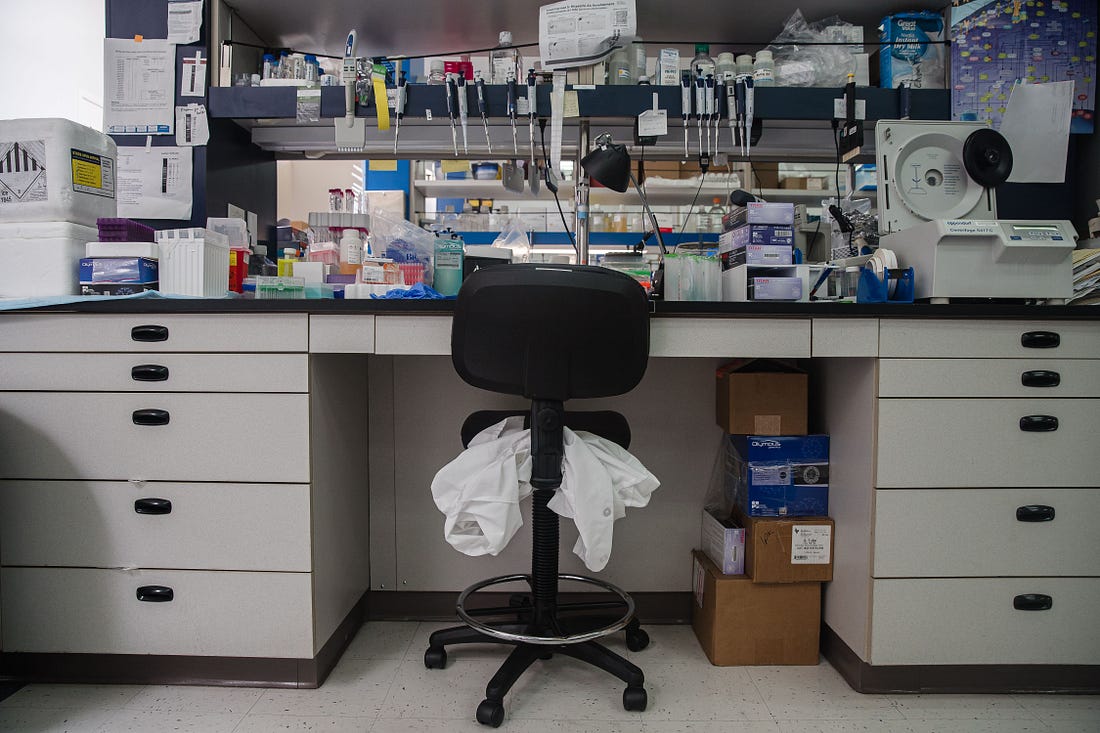Good afternoon, Press Pass readers. The Bulwark is all about getting you the most important information about our new political reality without bending what we say to fit into a partisan frame. Our goal is to deliver news and analysis that matters to you without wasting your time. If you want to become a part of our pro-democracy community and get access to all that we offer, consider signing up for a Bulwark+ subscription. Today’s edition takes you into the Trump administration’s proposal to cap federal grants from the National Institutes of Health (NIH) to recipients who use some of the money to cover the administrative costs of their projects. The move stunned medical professionals and researchers and caused confusion back on Capitol Hill. Next, it turns out that some of the elected Republicans who are praising Elon Musk’s DOGE activities in public are taking a very different tack in letters to their constituents. I also have a little pick-me-up to close out today’s newsletter: Vietnamese denim enthusiasts are getting over their country’s bad blood with the United States, and part of turning a new leaf involves embracing old Americana for their style inspiration. All that and more, below. The Trump administration issued a new rule Friday that could upend the way universities, institutes, and research centers develop treatments and discover cures for disease. The plan to cap “indirect costs” (those used for administrative functions) in grants awarded by the National Institutes of Health (NIH) at 15 percent has started a low-grade panic among medical professionals and researchers. A federal judge in Boston has already temporarily blocked the plan, but as with all of the new administration’s actions, this is only the beginning. Elon Musk has already decried it: “Judicially-mandated corruption!” Some lawmakers are concerned about the cap; while others are applauding it as another way to combat wasteful government spending. Fresh off voting to advance Robert F. Kennedy Jr.’s nomination to serve as secretary of health and human services through the committee stage, Sen. Bill Cassidy (R-La.) offered some cautious thoughts on the NIH’s new indirect cost cap. “I heard from my people back home that it would be very difficult for universities in Louisiana to conduct this research” with such a cap in place, Cassidy said. “And of course I want research done for the sake of my people in Louisiana.” Cassidy, who defended his RFK Jr. vote by saying he had secured commitments that the HHS nominee would show fidelity to science, added that he isn’t reconsidering his support. But some of his colleagues might—or they will at least feel the need to secure more “commitments” from Kennedy before his nomination goes to a floor vote likely later this week. “I oppose the poorly conceived directive imposing an arbitrary cap on the indirect costs that are part of NIH grants and negotiated between the grant recipient and NIH,” Sen. Susan Collins (R-Maine) said in a statement. She added that universities have been informed that the spending caps “in some cases would apply retroactively to existing grants,” and that they “would be devastating, stopping vital biomedical research and leading to the loss of jobs.” Collins said she also called Kennedy, who promised her he will “re-examine this initiative that was implemented prior to his confirmation” upon taking the reins at HHS. Later in her statement, Collins noted that “Fiscal Year 2024 Appropriations legislation includes language that prohibits the use of funds to modify NIH indirect costs.” There’s no telling whether that applies to the retroactive spending caps she previously mentioned—or whether the current administration would even care. While Collins highlighted the contributions that Maine universities have made to our understanding of Alzheimer’s and various tick-borne illnesses, NIH also funds many centers focusing specifically on pediatric care. The Boston Children’s Hospital received more than $200 million in NIH funds in FY2024. The Dana Farber Cancer Institute in Massachusetts received more than $164 million. The Cincinnati Children’s Hospital Medical Center in Ohio received a comparable $160 million. Children’s hospitals in Philadelphia, Seattle, and Memphis all received north of $100 million. In total, pediatric medical centers accounted for 31 of the organizations that received federal funding last year. I asked Sen. Bernie Moreno (R-Ohio) for his thoughts on the prospect of children’s hospitals—two of which are in his home state¹—facing financial hardship thanks to the spending cap directive. He didn’t balk at the idea or try to correct my facts. He welcomed the outcome. “Well, I think what happens is the president is exactly right,” Moreno said. “I think if you ask the average American if we were spending a billion dollars to cure childhood cancer, how much of the billion dollars would go towards during childhood cancer? They’d probably say a billion. The idea that 60 percent goes to indirect cost and overhead is insane. And so I applaud the president.” While Moreno clearly thinks funding for pediatric cancer research is an objectively good thing, his support for a cap on indirect costs would cripple that objective, advocates say. The senator is sidestepping what it takes for these hospitals in the current climate to do medical research. Children’s hospitals have described administrative support as being critical to their ability to conduct the very research Moreno says he supports. “The Administration’s new indirect cost guidelines will limit access to effective health care treatments and diagnostics for patients, and if implemented as currently drafted, will undermine our medical research capacity and put the nation’s health and global competitiveness at risk,” the Children’s Hospital Association said in a statement. “Reducing the indirect cost rate will threaten the ability of children’s hospitals to provide future groundbreaking cures for children.” There is bloat in how much money the federal government spends on indirect costs. And the White House could, in theory, redirect the money they are saving in implementing these caps towards the actual research itself. But the bloat is not as widespread as the White House alleges. And they have not said if they are going to redirect the savings back into research at all. As a result, they are threatening the critical fight against current diseases and the efforts to preempt future, unknown ones. Perhaps if this were better understood among Republican lawmakers, people like Moreno wouldn’t be so quick to applaud the administration for trying to excise wasteful spending with a chainsaw instead of a scalpel. I believe in Harvey DentYesterday, my colleague Sam Stein and I reported on the way many elected Republicans have been showing one face to the public and another to their constituents when it comes to DOGE. In response letters to inquiring constituents in their home states and districts, some Republicans who have publicly praised Elon Musk’s tinkering with sensitive government records and payment systems privately expressed concern and vigilance about establishing and limiting DOGE’s proper remit.
Later in the day, I caught up with Sen. Deb Fischer (R-Neb.), who seemed taken aback when I informed her of the letter bearing her signature that one of her constituents provided to us. I showed it to her on my phone, and after she read it, she looked up at me and said, “I, uh, I, uh, don’t talk to you guys very much.” (By “us,” she meant the media.) “And I, uh, obviously respond to my constituents. If you want to print that, you’re welcome to do it.” Nebraska is sending their best, I suppose. And she, in turn, is sending them all her best. “Jeans represent democracy in fashion” -Giorgio ArmaniIf you read our topper and connected some sartorial and geographical dots, you might be wondering how it could be that there’s a thriving subculture of denim enthusiasts in the hot and humid climate of Vietnam. Lots of reasons, it turns out, including safety and—most importantly—style. Denim is one of America’s greatest cultural exports. Like jazz music, rugged blue jeans are synonymous with American style. They’re a longstanding global phenomenon, one that has now found a new community of enthusiasts in Vietnam. In a new video posted by Stridewise, two Americans explored the denim scene in Ho Chi Minh City. A quote from one of the Vietnamese denim enthusiasts stuck out to me. When asked how on Earth such a uniquely American product could be so popular in a country so horribly treated by the United States, he said:
Time heals all wounds. (It also gives great fades to raw denim.) Watch the 13-minute mini documentary here. 1 These are the Cincinnati Children's Hospital Medical Center and the Research Institute at Nationwide Children’s Hospital in Columbus. You’re a free subscriber to Bulwark+. For unfettered access to all our newsletters and ad-free and member-only podcasts, become a paying subscriber. Did you know? You can update your newsletter preferences as often as you like. To update the list of newsletter or alerts you received from The Bulwark, click here. |




